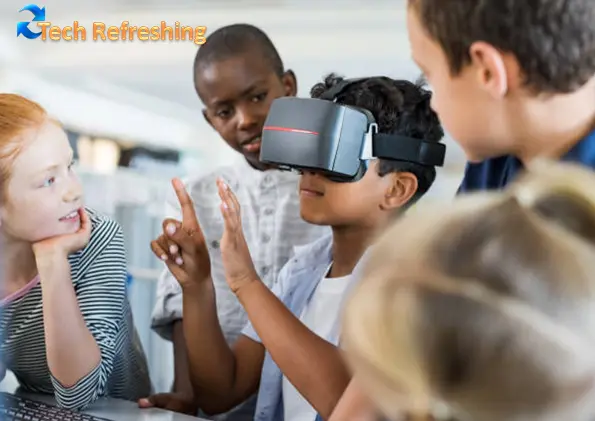Virtual reality (VR) has been around for many years, but only recently has its potential been realized in business and education. As technology continues to advance, VR is becoming increasingly accessible and affordable, making it an attractive tool for businesses and educational institutions. But how does virtual reality work? In this blog, we’ll explore the basics of VR, its benefits and challenges, and discuss the ways it’s being used in business and education today. Let’s get started by introducing virtual reality and understanding the basics.

Introduction to Virtual Reality
Virtual reality (VR) is a simulated experience that allows users to interact with a 3D environment. It typically involves the use of a headset, which can be wired or wireless, and a controller. The headset immerses the user in a computer-generated world, while the controller allows them to interact with the environment and objects within it. VR is often used for gaming, but it has applications in many other areas, including business and education.
Understanding the Basics of Virtual Reality
In order for VR to work, it must be able to create a realistic environment and respond in a way that is convincing to the user. To do this, modern VR systems use a combination of hardware, software, and sensors. The hardware is the headset, which contains the display and other components, such as lenses, sensors, and audio. The software is the 3D environment, which is generated by a computer and displayed on the headset’s display. Finally, the sensors are used to track the user’s movements, allowing them to interact with the environment in real time.
Benefits of Virtual Reality in Business
Virtual reality offers a variety of benefits for businesses. It can be used to create immersive training experiences, allowing employees to practice their skills in a safe and realistic environment. It can also be used to create virtual showrooms and exhibitions, allowing customers to explore products and services without actually being in the physical space. Additionally, VR can be used for product design and prototyping, allowing businesses to test ideas quickly and cost-effectively.
Benefits of Virtual Reality in Education
Virtual reality can also be a valuable tool in education. It can be used to create immersive learning experiences, allowing students to explore unfamiliar concepts and environments in a safe and engaging way. Additionally, VR can be used to provide students with access to experiences that would otherwise be unavailable, such as exploring the depths of the ocean or visiting a historical site. Finally, VR can be used for teaching students practical skills, such as flying a plane or performing surgery.
Types of Virtual Reality Technology
There are several types of virtual reality technology available today. The most common type is the head-mounted display (HMD), which consists of a headset and a controller. HMDs are typically used for gaming, but they can also be used for business and education applications. Another type of technology is the augmented reality (AR) headset, which overlays digital information onto the physical environment. AR can be used to provide users with additional information, such as directions or product specifications.
Best Practices for Implementing Virtual Reality
When implementing virtual reality, it’s important to follow best practices. First, it’s important to ensure the hardware and software are up-to-date and properly configured. Additionally, it’s important to design the environment in a way that is intuitive and engaging for users. Finally, it’s important to provide adequate training and support to ensure users understand how to use the system.
Challenges of Virtual Reality Works in Business & Education
Despite its many benefits, there are still some challenges associated with virtual reality. The biggest challenge is cost, as VR systems can be expensive to purchase and maintain. Additionally, VR can be difficult to implement, as it requires a combination of hardware, software, and sensors. Finally, there is still a lack of quality content available for VR, which can limit the usefulness of the technology.
Examples of Virtual Reality in Business & Education
There are a variety of ways businesses and educational institutions are using virtual reality. For example, many companies are using it for training purposes, allowing employees to practice difficult tasks in a safe and realistic environment. Additionally, many schools are using VR for field trips, allowing students to explore faraway places without leaving the classroom. Finally, many museums and galleries are using VR to provide visitors with a unique and immersive experience.
The Future of Virtual Reality in Business & Education
The potential of virtual reality is only beginning to be realized. As technology continues to advance, VR will become increasingly accessible and affordable. This will open the door for more businesses and educational institutions to explore the possibilities of VR, creating exciting and innovative experiences.
Conclusion
Virtual reality has the potential to revolutionize the way businesses and educational institutions operate. By understanding the basics of how it works and the benefits and challenges of using it, organizations can make informed decisions about whether or not to implement it. As technology continues to advance, the possibilities of VR will only increase, allowing businesses and educational institutions to create innovative and immersive experiences.



